Classification System: APG IV
Superregnum: Eukaryota
Regnum: Plantae
Cladus: Angiosperms
Cladus: Monocots
Ordo: Asparagales
Familia: Asparagaceae
Subfamilia: Agavoideae
Genus: Yucca
Sectiones: Y. sect. Chaenocarpa - Y. sect. Clistocarpa - Y. sect. Endlichiana - Y. sect. Hesperoyucca - Y. sect. Yucca
Species: Y. aloifolia - Y. angustissima - Y. arkansana - Y. baccata - Y. baileyi - Y. brevifolia - Y. campestris - Y. capensis - Y. carnerosana – Y. cernua – Y. coahuilensis – – Y. declinata – Y. de-smetiana – Y. elata – Y. endlichiana – Y. faxoniana - Y. filamentosa – Y. filifera – Y. flaccida – Y. gigantea - Y. glauca - – Y. gloriosa – Y. grandiflora – Y. harrimaniae – Y. intermedia – Y. jaliscensis – Y. lacandonica – Y. linearifolia – Y. luminosa – Y. madrensis – Y. mixtecana – Y. necopina – Y. neomexicana – Y. pallida – Y. periculosa – Y. potosina – Y. queretaroensis – Y. reverchonii – Y. rostrata - Y. rupicola - Y. schidigera – Y. sterilis – Y. tenuistyla – Y. thompsoniana – Y. treculeana – Y. utahensis – Y. validaY. constricta - Y. decipiens
Nothospecies: Y. × andreana – Y. × baccatissima – Y. × bacsoniana – Y. × baylissima – Y. × consana – Y. × feeanoukiae – Y. × glaucissima – Y. × intermediate – Y. × karlsruhensis – Y. × keithii – Y. × necopina – Y. × oklahomensis – Y. × pollyjeaniae – Y. × quinnarjenii – Y. x schottii
Name
Yucca L. (1753)
Type species: Yucca aloifolia L.
Synonyms
Homotypic
Iuka Adans., Fam. 2: 567. 1763.
Heterotypic
Codonocrinum Willd. ex Schult. & Schult.f. in Roemer & Schult., Syst. Veg. 7: 718. 1829.
Type species: Codonocrinum agavoides Willd. ex Schult.f.
Clistoyucca (Engelm.) Trel., Rep. (Annual) Missouri Bot. Gard. 13: 41. 1902.
Type species: Clistoyucca arborescens Trel.
Samuela Trel., Rep. (Annual) Missouri Bot. Gard. 13: 116. 1902.
Type species: non design.
Sarcoyucca (Trel.) Linding., Beih. Bot. Centralbl. 50(1): 446. 1933.
Type species: Sarcoyucca aloifolia (L.) Linding.
References
Linnaeus, C. 1753. Species Plantarum 1: 319.
Govaerts, R. et al. 2015. Yucca in World Checklist of Selected Plant Families. The Board of Trustees of the Royal Botanic Gardens, Kew. Published on the internet. Accessed: 2015 June 22. Reference page.
Hochstetter, C.F.F. (2000) Yucca (Agavaceae). Band 1 Dehiscent-fruited species in the Southwest and Midwest of the USA, Canada and Baja California, Selbst Verlag, 2000. ISBN 3-00-005946-6
Hochstetter, C.F.F. (2002) Yucca (Agavaceae). Band 2 Indehiscent-fruited species in the Southwest, Midwest and East of the USA, Selbst Verlag. 2002. ISBN 3-00-009008-8
Hochstetter, C.F.F. (2004) Yucca (Agavaceae). Band 3 Mexico, Selbst Verlag, 2004. ISBN 3-00-013124-8
International Plant Names Index. 2015. Yucca. Published online. Accessed: June 22 2015.
Global Biodiversity Information Facility. 2019. GBIF Backbone Taxonomy. Checklist dataset. Taxon: Yucca. .
Tropicos.org 2015. Yucca. Missouri Botanical Garden. Published on the internet. Accessed: 2015 June 22.
Vernacular names
Deutsch: Palmlilien
suomi: Jukat
հայերեն: Արմավաշուշան, ադամի ասեղ
русский: Юкка
svenska: Palmliljesläktet
Yucca is a genus of perennial shrubs and trees in the family Asparagaceae, subfamily Agavoideae.[2] Its 40–50 species are notable for their rosettes of evergreen, tough, sword-shaped leaves and large terminal panicles of white or whitish flowers. They are native to the hot and dry (arid) parts of the Americas and the Caribbean.
Early reports of the species were confused with the cassava (Manihot esculenta).[3] Consequently, Linnaeus mistakenly derived the generic name from the Taíno word for the latter, yuca.[4]
Distribution
Distribution of the capsular fruited species in southwest, midwest USA, Mexico's Baja California and Canada, overview
The natural distribution range of the genus Yucca (49 species and 24 subspecies) covers a vast area of the Americas. The genus is represented throughout Mexico and extends into Guatemala (Yucca guatemalensis). It also extends to the north through Baja California in the west, northwards into the southwestern United States, through the drier central states as far north as southern Alberta in Canada (Yucca glauca ssp. albertana).
Yucca is also native to some of the Caribbean Islands, northward to the coastal lowlands and dry beach scrub of the coastal areas of the southeastern United States, along the Gulf of Mexico and South Atlantic States from coastal Texas to Maryland.
Yuccas have adapted to an equally vast range of climatic and ecological conditions. They are to be found in rocky deserts and badlands, in prairies and grassland, in mountainous regions, in light woodland, in coastal sands (Yucca filamentosa), and even in subtropical and semitemperate zones, although these are generally arid to semi-arid.
Ecology
Yuccas have a very specialized, mutualistic pollination system, being pollinated by yucca moths (family Prodoxidae); the insect transfers the pollen from the stamens of one plant to the stigma of another, and at the same time lays an egg in the flower; the moth larva then feeds on some of the developing seeds, always leaving enough seed to perpetuate the species. Certain species of the yucca moth have evolved antagonistic features against the plant and do not assist in the plant's pollination efforts while continuing to lay their eggs in the plant for protection.[5]
Yucca species are the host plants for the caterpillars of the yucca giant-skipper (Megathymus yuccae),[6] ursine giant-skipper (Megathymus ursus),[7] and Strecker's giant-skipper (Megathymus streckeri).[8]
Large Joshua tree with thick trunk at Grapevine Springs Ranch, AZ
Purplish fruits of Yucca aloifolia.
Beetle herbivores include yucca weevils, in the Curculionidae.
Adaptations
Species of yucca have adapted to a wide variety of climates in mountains, coastal sand, grasslands and prairies as well as rocky badlands and deserts. Most species of yucca have thick, waxy skins to prevent loss of water through evaporation.
Uses
Yuccas are widely grown as ornamental plants in gardens. Many species also bear edible parts, including fruits, seeds, flowers, flowering stems,[9] and more rarely roots. References to yucca root as food often arise from confusion with the similarly pronounced, but botanically unrelated, yuca, also called cassava or manioc (Manihot esculenta). Roots of soaptree yucca (Yucca elata) are high in saponins and are used as a shampoo in Native American rituals. Dried yucca leaves and trunk fibers have a low ignition temperature, making the plant desirable for use in starting fires via friction. The stem (when dried) that sports the flowers is often used in collaboration with a sturdy piece of cedar for fire making.[10] In rural Appalachian areas, species such as Yucca filamentosa are referred to as "meat hangers". The tough, fibrous leaves, with their sharp-spined tips, were used to puncture meat and knotted to form a loop with which to hang meat for salt curing or in smoke houses. The fibers can be used to make cordage, be it sewing thread or rope.
Gastronomy
The flower petals are commonly eaten in Central America, but its reproductive organs (the anthers and ovaries) are first removed because of their bitterness.[11] The petals are blanched for 5 minutes, and then cooked a la mexicana (with tomato, onion, chili) or in tortitas con salsa (egg-battered patties with green or red sauce). In Guatemala, they are boiled and eaten with lemon juice.[11]
In El Salvador, the tender tips of stems are eaten, and known locally as cogollo de izote.[11]
Cultivation
Yuccas are widely grown as architectural plants providing a dramatic accent to landscape design. They tolerate a range of conditions, but are best grown in full sun in subtropical or mild temperate areas. In gardening centres and horticultural catalogues they are usually grouped with other architectural plants such as cordylines and phormiums.[12]
Joshua trees (Yucca brevifolia) are protected by law in some states. A permit is needed for wild collection. As a landscape plant, they can be killed by excessive water during their summer dormant phase, so are avoided by landscape contractors.
Several species of yucca can be grown outdoors in temperate climates, including:-[12]
Yucca filamentosa
Yucca flaccida
Yucca gigantea
Yucca gloriosa
Yucca recurvifolia
Symbolism
The yucca flower is the state flower of New Mexico in the southwest United States. No species name is given in the citation; however, the New Mexico Centennial Blue Book from 2012 references the soaptree yucca (Yucca elata) as one of the more widespread species in New Mexico.[N 1]
As well, it is the national flower of El Salvador, where it is known as "flor de izote".
Species
As of February 2012, the World Checklist of Selected Plant Families recognizes 49 species of Yucca and a number of hybrids:[13]
| Plant | Flowers | Species name | Common name |
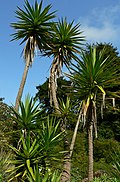 |
 |
Yucca aloifolia L. (Type species) (syn. Yucca yucatana) | Aloe yucca, Spanish bayonet |
 |
 |
Yucca angustissima Engelm. ex Trel. (including Yucca kanabensis) | Narrowleaf yucca, Spanish bayonet |
 |
 |
Yucca arkansana Trel. | |
 |
 |
Yucca baccata Torr. (including Yucca thornberi) | Banana yucca, datil |
 |
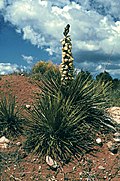 |
Yucca baileyi Wooton & Standl. (syn. Yucca standleyi McKelvey) | |
 |
 |
Yucca brevifolia Engelm. | Joshua tree |
 |
Yucca campestris McKelvey | ||
 |
Yucca capensis L.W.Lenz | ||
 |
Yucca carnerosana (Trel.) McKelvey | ||
 |
 |
Yucca cernua E.L.Keith | |
 |
Yucca coahuilensis Matuda & I.L.Pina | ||
 |
Yucca constricta Buckley | Buckley's yucca | |
 |
 |
Yucca decipiens Trel. | Palma china |
| Yucca declinata Laferr. | |||
| Yucca desmetiana Baker | |||
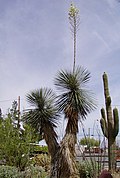 |
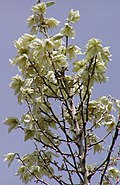 |
Yucca elata (Engelm.) Engelm. | Soaptree yucca |
 |
Yucca endlichiana Trel. | ||
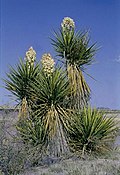 |
Yucca faxoniana Sarg. (syn. Yucca torreyi) | Torrey yucca | |
 |
 |
Yucca filamentosa L. | Spoonleaf yucca, filament yucca, or Adam's needle |
 |
Yucca filifera Chabaud | Palma china | |
 |
Yucca flaccida Haw. | Flaccid leaf yucca | |
 |
Yucca gigantea Lem. (syn. Yucca guatemalensis) | Spineless yucca | |
 |
 |
Yucca glauca Nutt. | Great Plains yucca |
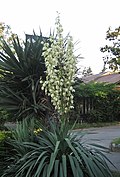 |
Yucca gloriosa L. (including Yucca recurvifolia) | Moundlily yucca, Adam's needle, Spanish dagger | |
 |
Yucca grandiflora Gentry | Sahuiliqui yucca | |
 |
 |
Yucca harrimaniae Trel. (syn. Yucca nana) | Harriman's yucca |
 |
Yucca intermedia McKelvey | Intermediate yucca | |
 |
Yucca jaliscensis (Trel.) Trel. | Izote | |
 |
Yucca lacandonica Gómez Pompa & J.Valdés | Tropical yucca | |
 |
Yucca linearifolia Clary | ||
 |
Yucca luminosa (syn. Yucca rigida) | Blue yucca | |
| Yucca madrensis Gentry | Soco yucca | ||
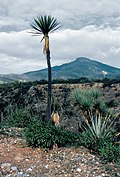 |
Yucca mixtecana García-Mend. | ||
| Yucca necopina Shinners | |||
 |
Yucca neomexicana Wooton & Standl. | New Mexican Spanish bayonet | |
 |
Yucca pallida McKelvey | Pale yucca | |
 |
Yucca periculosa Baker | Izote | |
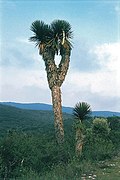 |
Yucca potosina Rzed. | ||
 |
Yucca queretaroensis Piña Luján | ||
 |
Yucca reverchonii Trel. | ||
 |
Yucca rostrata Engelm. ex Trel. | Beaked yucca, Big Bend yucca | |
 |
Yucca rupicola Scheele | Texas yucca, or twist-leaf yucca | |
 |
Yucca schidigera Roezl ex Ortgies | Mojave yucca | |
 |
Yucca × schottii | Hoary yucca or mountain yucca | |
 |
Yucca sterilis (Neese & S.L.Welsh) S.L.Welsh & L.C.Higgins | ||
| Yucca tenuistyla Trel. | |||
 |
 |
Yucca thompsoniana Trel. | Thompson's yucca |
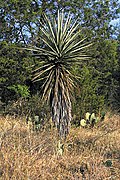 |
 |
Yucca treculeana Carrière | Texas bayonet, Trecul's yucca |
 |
 |
Yucca utahensis McKelvey | |
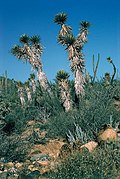 |
Yucca valida Brandegee | Datilillo |
A number of other species previously classified in Yucca are now classified in the genera Dasylirion, Furcraea, Hesperaloe, Hesperoyucca, and Nolina.
Cultivars
In the years from 1897 to 1907, Carl Ludwig Sprenger created and named 122 Yucca hybrids.
Notes
No species name is listed in state statutes, however the New Mexico Centennial Blue Book from 2012 references the soaptree yucca (Yucca elata) as one of the more widespread species in New Mexico.
References
"Yucca L." Germplasm Resources Information Network. United States Department of Agriculture. 2010-01-19. Retrieved 2010-06-07.
Chase, M.W.; Reveal, J.L. & Fay, M.F. (2009), "A subfamilial classification for the expanded asparagalean families Amaryllidaceae, Asparagaceae and Xanthorrhoeaceae", Botanical Journal of the Linnean Society, 161 (2): 132–136, doi:10.1111/j.1095-8339.2009.00999.x
Irish, Gary (2000). Agaves, Yuccas, and Related Plants: a Gardener's Guide. Timber Press. p. 18. ISBN 978-0-88192-442-8.
Quattrocchi, Umberto (2000). CRC World Dictionary of Plant Names. 4 R-Z. Taylor & Francis US. p. 2862. ISBN 978-0-8493-2678-3.
Segraves, Kari A.; Althoff, David M. & Pellmyr, Olle (1 October 2008). "The evolutionary ecology of cheating: does superficial oviposition facilitate the evolution of a cheater yucca moth?". Ecological Entomology. 33 (6): 765–770. doi:10.1111/j.1365-2311.2008.01031.x. S2CID 55871573.
Daniels, Jaret C. "Yucca Giant-Skipper Butterfly, Megathymus yuccae (Boisduval & Leconte) (Insecta: Lepidoptera: Hesperiidae)". Electronic Data Information Source. University of Florida IFAS Extension. Retrieved 2010-06-07.
"Ursine Giant-Skipper Megathymus ursus Poling, 1902". Butterflies and Moths of North America. Retrieved 2010-06-07.
"Strecker's Giant-Skipper Megathymus streckeri (Skinner, 1895)". Butterflies and Moths of North America. Retrieved 2010-06-07.
Couplan, François (1998). The Encyclopedia of Edible Plants of North America. McGraw Hill Professional. ISBN 978-0-87983-821-8.
Baugh, Dick (1999). "the Miracle of Fire by Friction". In David Wescott (ed.). Primitive Technology: A Book of Earth Skills (10 ed.). pp. 32–33. ISBN 978-0-87905-911-8.
Pieroni, Andrea (2005). Prance, Ghillean; Nesbitt, Mark (eds.). The Cultural History of Plants. Routledge. p. 33. ISBN 0415927463.
RHS A-Z encyclopedia of garden plants. United Kingdom: Dorling Kindersley. 2008. p. 1136. ISBN 978-1405332965.
World Checklist of Selected Plant Families, The Board of Trustees of the Royal Botanic Gardens, Kew, retrieved 2012-02-23, search for "Yucca"
General
Fritz Hochstätter (Hrsg.): Yucca (Agavaceae). Band 1 Dehiscent-fruited species in the Southwest and Midwest of the USA, Canada and Baja California , Selbst Verlag, 2000. ISBN 3-00-005946-6
Fritz Hochstätter (Hrsg.): Yucca (Agavaceae). Band 2 Indehiscent-fruited species in the Southwest, Midwest and East of the USA, Selbst Verlag. 2002. ISBN 3-00-009008-8
Fritz Hochstätter (Hrsg.): Yucca (Agavaceae). Band 3 Mexico , Selbst Verlag, 2004. ISBN 3-00-013124-8
Retrieved from "http://en.wikipedia.org/"
All text is available under the terms of the GNU Free Documentation License

